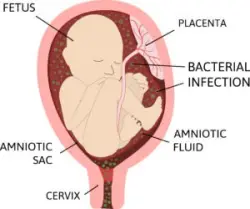
The term “Chorio baby” refers to a child suffering from a medical condition known as chorioamnionitis. Chorioamnionitis is a form of infection that targets a mother’s placenta and amniotic fluid. These infections can impact mother and child alike. This infection results from bacteria, and it can occur either before or during labor.
Like most infections, chorioamnionitis is treatable in both the mother and the child. However, any delays in diagnosing this condition could complicate recovery. In some cases, the failure to treat this condition in a timely manner could have devastating consequences.
Causes of Chorioamnionitis in Babies
The primary cause of infant chorioamnionitis is a maternal infection. These infections occur when bacteria common to the vagina causes an infection. Common bacteria that cause infant chorioamnionitis include E. coli and group B streptococci. When tears are present in the amniotic sac, that infection can spread to a child while still in the womb. The longer the amniotic sac is broken before birth, the more likely it is that this infection could affect the child.
Certain risk factors make some mothers more likely than others to develop this infection. Young mothers—typically under the age of 21—are the most at risk. First-time mothers of all ages are also at higher risk of infection, as are mothers that experience long, difficult labor. The use of alcohol or tobacco is also a factor.
Not all infections occur due to natural or unavoidable causes. In some cases, medical errors or mistakes can lead to cases of infant chorioamnionitis. One common example is the use of excessive fetal monitoring during pregnancy. This monitoring could damage the amniotic sac, increasing the risk of infection. Mistakes during vaginal exams or through the administration of an epidural could also damage the amniotic sac.
"If your child was born with a birth injury, or cerebral palsy, we can help."
Diagnosis of Chorioamnionitis
According to PubMed, many infants exposed to chorioamnionitis in the womb are asymptomatic. In other words, while serious infections within infants are rare, many babies are exposed to some chorioamnionitis while in the womb. Given the potentially large number of children with exposure, it is important to understand the steps to diagnosing this condition.
There are no outward signs of chorioamnionitis. However, simple tests can assist medical professionals in diagnosing infection. The most common sign is an unexplained increase in heart rate for the mother and baby. A maternal fever is also a common sign of an infection that could have also spread to the baby.
The symptoms of chorioamnionitis in an infant can be severe. These symptoms can include:
- Fatigue
- Weak cries
- Poor latch during breastfeeding
- Vomiting or diarrhea
- Seizures
- Respiratory distress
- Pallor
- Purpura
If these signs are ignored, the potential health consequences for the child could be severe. Serious infections could spread to the lungs or spinal cord, resulting in a host of complications. Some infants could develop pneumonia, which can be fatal. The lack of oxygen could also result in brain complications for the child.
There are tests that can be given to the mother to screen for infection risk facts. As group B strep is a common cause, lab tests that can identify or rule out group B strep in the mother’s blood or urine could be helpful. Tests of the mother’s white blood cell counts could also inform the doctor of the risks of an infection.
Treating Chorio Babies
Treatment for chorioamnionitis should begin as soon as a doctor detects its presence within an infant. This detection can occur in the womb, during childbirth, or shortly after delivery.
Because of the serious nature of this condition, the primary treatment for infants suffering from chorioamnionitis in the womb is a rapid delivery. Treating the infant and mother together with antibiotics is possible, but often the risk of complications requires a hasty delivery to allow doctors to administer treatment directly to the newborn.
For newborns suffering from the infection, treatment typically involves the direct application of antibiotics. In most cases, antibiotics are enough to flush the infection from the infant’s system. In advanced cases, doctors may need to take additional measures. This is especially common in cases where infants are experiencing respiratory distress. Some of the treatment options include:
- Intubation
- Ventilation
- Artificial breathing tubes
- Balancing of glucose levels
When these treatments are applied in short order, the infant is likely to make a full recovery with no long-term health consequences.
"We know first-hand what you are going through."
Contact the Office of a Birth Injury Lawyer to Discuss an Infant Chorioamnionitis Diagnosis Today
The unfortunate reality of chorioamnionitis is that it often leads to long-term or permanent health complications. Given the readily available treatments for these infections, most severe cases occur due to medical mistakes. These can include the failure to properly diagnose the condition, the lack of appropriate treatment, or even consequences for allowing the spread of the infection due to medical injuries during the mother’s gynecological exams.
Understanding what a chorio baby is and how this condition occurs is invaluable to protecting your child’s legal rights. If your child suffered the effects of infant chorioamnionitis, you could be entitled to pursue a legal claim against the negligent medical providers that were responsible for the infection. To learn more, schedule a free consultation with the Birth Injury Lawyers Group by calling (800) 222-9529.
"We are committed to helping families who have suffered medical negligence."

